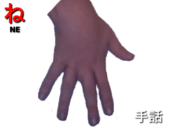Ne (kana)
ね, in hiragana, or ネ in katakana, is one of the Japanese kana, each of which represents one mora. The hiragana is made in two strokes, while the katakana is made in four. Both represent [ne].
| ne | ||||
|---|---|---|---|---|
| ||||
| transliteration | ne | |||
| hiragana origin | 祢 | |||
| katakana origin | 祢 | |||
| spelling kana | ねずみのネ (Nezumi no ne) | |||
| kana gojūon | ||||||||||||||||||||||||||||||||||||||||||||||||||
|---|---|---|---|---|---|---|---|---|---|---|---|---|---|---|---|---|---|---|---|---|---|---|---|---|---|---|---|---|---|---|---|---|---|---|---|---|---|---|---|---|---|---|---|---|---|---|---|---|---|---|
|
||||||||||||||||||||||||||||||||||||||||||||||||||
As a particle, it is used at the end of a sentence, equivalent to an English, "right?" or "isn't it?" It is also used as slang in Japan to get someone's attention, the English equivalent being "hey" or "hey, you."
| Form | Rōmaji | Hiragana | Katakana |
|---|---|---|---|
| Normal n- (な行 na-gyō) |
ne | ね | ネ |
| nei nee nē |
ねい, ねぃ ねえ, ねぇ ねー |
ネイ, ネィ ネエ, ネェ ネー |
Stroke order
 Stroke order in writing ね |
 Stroke order in writing ネ |

Stroke order in writing ね

Stroke order in writing ネ
Other communicative representations
| Japanese radiotelephony alphabet | Wabun Code |
| ねずみのネ Nezumi no "Ne" |
 |
|
 |
 |
| Japanese Navy Signal Flag | Japanese semaphore | Japanese manual syllabary (fingerspelling) | Braille dots-1234 Japanese Braille |
- Full Braille representation
| ね / ネ in Japanese Braille | |
|---|---|
| ね / ネ ne | ねい / ネー nē/nei |
| Look up ね or ネ in Wiktionary, the free dictionary. |
| Character | ね | ネ | ネ | |||
|---|---|---|---|---|---|---|
| Unicode name | HIRAGANA LETTER NE | KATAKANA LETTER NE | HALFWIDTH KATAKANA LETTER NE | |||
| Encodings | decimal | hex | decimal | hex | decimal | hex |
| Unicode | 12397 | U+306D | 12493 | U+30CD | 65416 | U+FF88 |
| UTF-8 | 227 129 173 | E3 81 AD | 227 131 141 | E3 83 8D | 239 190 136 | EF BE 88 |
| Numeric character reference | ね | ね | ネ | ネ | ネ | ネ |
| Shift JIS | 130 203 | 82 CB | 131 108 | 83 6C | 200 | C8 |
This article is issued from Wikipedia. The text is licensed under Creative Commons - Attribution - Sharealike. Additional terms may apply for the media files.

